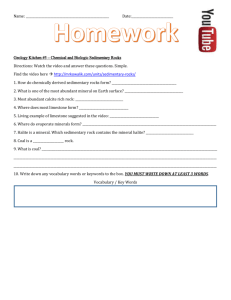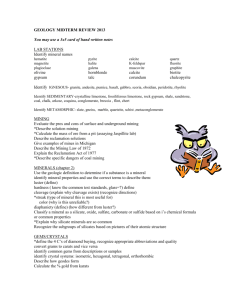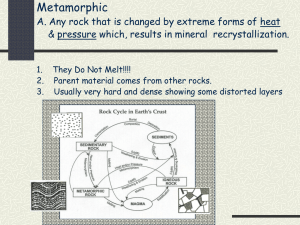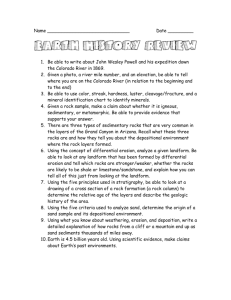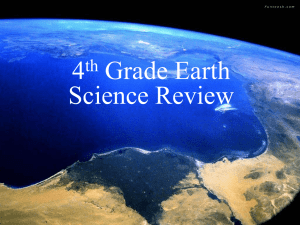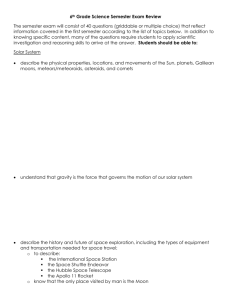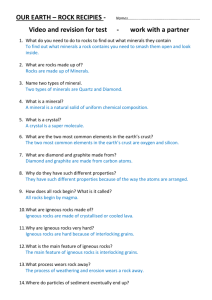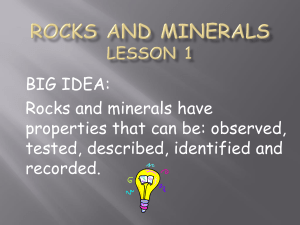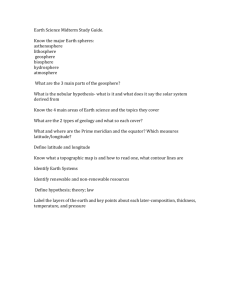File
advertisement
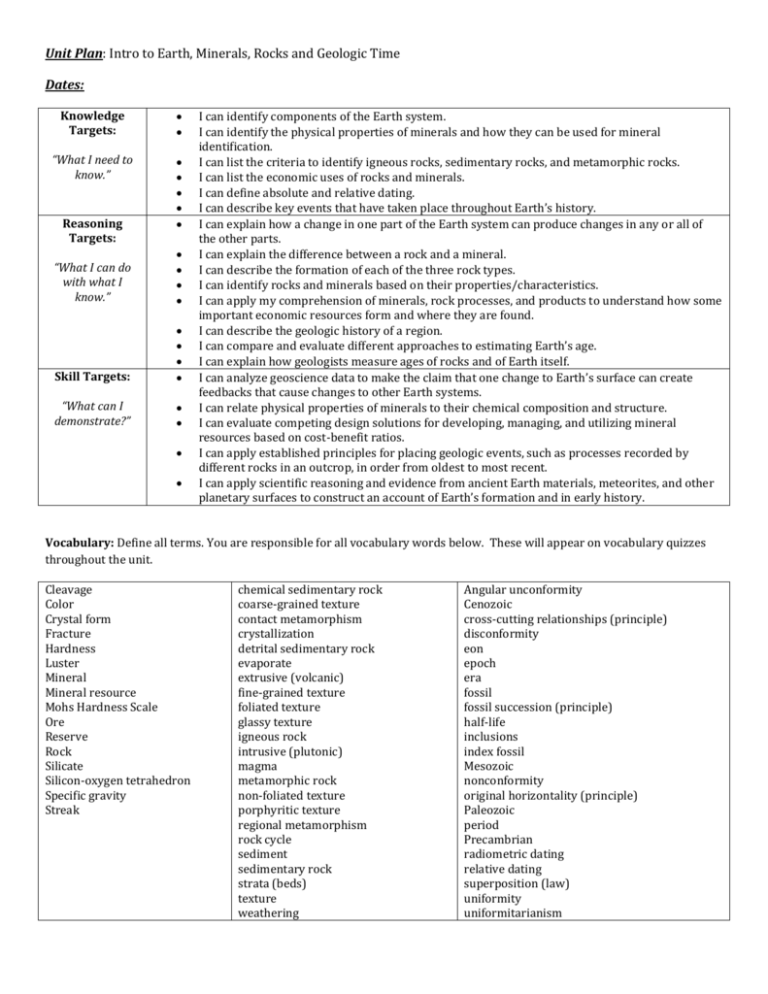
Unit Plan: Intro to Earth, Minerals, Rocks and Geologic Time Dates: Knowledge Targets: “What I need to know.” Reasoning Targets: “What I can do with what I know.” Skill Targets: “What can I demonstrate?” I can identify components of the Earth system. I can identify the physical properties of minerals and how they can be used for mineral identification. I can list the criteria to identify igneous rocks, sedimentary rocks, and metamorphic rocks. I can list the economic uses of rocks and minerals. I can define absolute and relative dating. I can describe key events that have taken place throughout Earth’s history. I can explain how a change in one part of the Earth system can produce changes in any or all of the other parts. I can explain the difference between a rock and a mineral. I can describe the formation of each of the three rock types. I can identify rocks and minerals based on their properties/characteristics. I can apply my comprehension of minerals, rock processes, and products to understand how some important economic resources form and where they are found. I can describe the geologic history of a region. I can compare and evaluate different approaches to estimating Earth’s age. I can explain how geologists measure ages of rocks and of Earth itself. I can analyze geoscience data to make the claim that one change to Earth’s surface can create feedbacks that cause changes to other Earth systems. I can relate physical properties of minerals to their chemical composition and structure. I can evaluate competing design solutions for developing, managing, and utilizing mineral resources based on cost-benefit ratios. I can apply established principles for placing geologic events, such as processes recorded by different rocks in an outcrop, in order from oldest to most recent. I can apply scientific reasoning and evidence from ancient Earth materials, meteorites, and other planetary surfaces to construct an account of Earth’s formation and in early history. Vocabulary: Define all terms. You are responsible for all vocabulary words below. These will appear on vocabulary quizzes throughout the unit. Cleavage Color Crystal form Fracture Hardness Luster Mineral Mineral resource Mohs Hardness Scale Ore Reserve Rock Silicate Silicon-oxygen tetrahedron Specific gravity Streak chemical sedimentary rock coarse-grained texture contact metamorphism crystallization detrital sedimentary rock evaporate extrusive (volcanic) fine-grained texture foliated texture glassy texture igneous rock intrusive (plutonic) magma metamorphic rock non-foliated texture porphyritic texture regional metamorphism rock cycle sediment sedimentary rock strata (beds) texture weathering Angular unconformity Cenozoic cross-cutting relationships (principle) disconformity eon epoch era fossil fossil succession (principle) half-life inclusions index fossil Mesozoic nonconformity original horizontality (principle) Paleozoic period Precambrian radiometric dating relative dating superposition (law) uniformity uniformitarianism Key Ideas/Questions to Consider: You should reflect/answer these questions on your own time throughout the unit. What are the properties of minerals? How do elements combine to make minerals? What is a mineral? Which minerals are most important? How and where do rocks form? How are the rock classes related to one another? What are igneous processes? How are igneous rocks classified? Where do igneous rocks appear in a landscape? How and why do rocks melt? How is magma made? How does magma generation relate to plate tectonics? What makes igneous rock compositions so diverse? How and why do rocks disintegrated to form sediment? What is the link between weathering and sediment? How does loose sediment become sedimentary rock? How are sedimentary rocks classified? Why are fossils and fossil fuels found in sedimentary rocks? How do sedimentary rocks reveal ancient environments? What is metamorphism? What roles do temperature and pressure play in metamorphism? What role does fluid play in metamorphism? Why do metamorphic rocks exist at the surface? Where does metamorphism take place? How do we describe rock age? How are geologic events placed in order? How was the geologic time scale constructed? Homework: Guided questions to help you study for homework/reading quizzes throughout the unit. Key idea questions (above) may appear on quizzes as well. Although all minerals have an orderly internal arrangement of atoms (crystalline structure), most mineral samples do not visibly demonstrate their crystal form. Why? Why might it be difficult to identify a mineral by its color? If you found a glassy-appearing mineral while rock hunting and had hopes it was a diamond, what simple test might help you make this determination? Explain the statement, “One rock is the raw material for another” using the rock cycle. What does a porphyritic texture indicate about the history of an igneous rock? How are granite and rhyolite different? The same? Relate the classification of igneous rocks to Bowen’s reaction series. What minerals are most common in detrital sedimentary rocks? Why are these minerals so abundant? What is the primary basis for distinguishing among various detrital sedimentary rocks? Distinguish between the two categories of chemical sedimentary rocks. What is probably the single most important characteristic feature of sedimentary rocks? What is metamorphism? What are the agents of change? What feature would easily distinguish schist and gneiss from quartzite and marble? Nonmetallic resources are commonly divided into two broad groups. List the two groups and some examples of materials that belong to each. List and briefly describe at least five different types of fossils. List two conditions that improve an organism’s chances of being preserved as a fossil. How are fossils helpful in geologic investigations? Explain why Precambrian history is more difficult to decipher than more recent geologic history. Identify key events of the following time spans: Precambrian, early Paleozoic, late Paleozoic, Mesozoic, Cenozoic.
